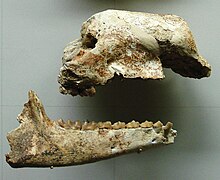| Diplobune | |
|---|---|

| |
| Diplobune sp. cranial remains, State Museum of Natural History Stuttgart | |
| Scientific classification | |
| Domain: | Eukaryota |
| Kingdom: | Animalia |
| Phylum: | Chordata |
| Class: | Mammalia |
| Order: | Artiodactyla |
| Family: | †Anoplotheriidae |
| Subfamily: | †Anoplotheriinae |
| Genus: | †Diplobune Rütimeyer, 1862 |
| Type species | |
| †Diplobune minor Filhol, 1877
| |
| Other species | |
| Synonyms | |
|
Genus synonymy
Synonyms of D. secundaria
Synonyms of D. bavarica
| |
Diplobune (Ancient Greek: διπλοῦς (double) + βουνός (hill) meaning "double hill") is an extinct genus of Palaeogene artiodactyls belonging to the family Anoplotheriidae. It was endemic to Europe and lived from the late Eocene to the early Oligocene. The genus was first erected as a subgenus of Dichobune by Ludwig Rütimeyer in 1862 based on his hypothesis of the taxon being a transitional form between "Anoplotherium" secundaria, previously erected by Georges Cuvier in 1822, and Dichobune. He based the genus etymology off of the two-pointed pillarlike shapes of the lower molars, which had since been a diagnosis of it. However, in 1870, Diplobune was elevated to genus rank by Oscar Fraas, who recognized that Diplobune was a distinct genus related to Anoplotherium and not Dichobune. After several revisions of the anoplotheriids, there are currently four known species of which D. minor is the type species.
Diplobune was an evolutionarily derived medium to large-sized anoplotheriid with shared similarities to the sister taxon Anoplotherium; the differences mainly consisting of all species having specialized three-fingered limbs and various specific dental, postcranial, and brain anatomy differences. It was well-adapted for purely folivorous diets, with dentition capable of chewing through hard leaf material and an implied presence of tapered tongues for reaching branches similar to modern-day giraffids. Its limbs were very specialized of which there are no modern analogues, especially in artiodactyls, with implied powerful muscles for some extent of mobility in the form of bending its fingers, especially its left, shortest finger (finger II).
Such unique traits along with hints of slow-walking locomotion suggest a life of arborealism or semi-arborealism, where it was likely able to grasp onto hard objects for climbing them. These traits would have set it apart in lifestyle from Anoplotherium, the Palaeotheriidae, and most other mammals that it coexisted with. Although the sizes of several species are not described, D. secundaria of the late Eocene was estimated to weigh approximately 130 kg (290 lb) and measure about 2 m (6 ft 7 in) in length and 1.2 m (3 ft 11 in) in shoulder height, whereas D. minor of the early Oligocene was much smaller with estimated weights of 20 kg (44 lb).
The evolutionary history of Diplobune is not complete, but it lived in western Europe back when it was an archipelago that was isolated from the rest of Eurasia, meaning that it lived in an environment with various other faunas that also evolved with strong levels of endemism. It, like Anoplotherium, arose long after a shift towards drier but still subhumid conditions that led to abrasive plants and the extinctions of the large-sized Lophiodontidae, becoming a regular component of late Eocene faunal communities. It survived through the Grande Coupure extinction event of western Europe in the earliest Oligocene but seemingly lost at least one species in the process. D. minor appeared in the early Oligocene as likely the last representative of the Anoplotheriidae, leaning towards specialization in forested, subhumid environments with freshwater bodies.